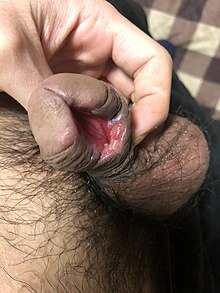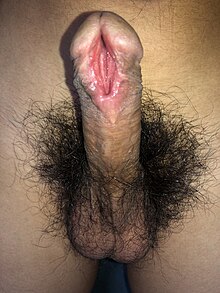Penile subincision

Penile subincision is a form of genital modification or mutilation consisting of a urethrotomy, in which the underside of the penis is incised and the urethra slit open lengthwise, from the urethral opening (meatus) toward the base. The slit can be of varying lengths.
Subincision was traditionally performed around the world, notably in Australia, but also in Africa, South America and the Polynesian and Melanesian cultures of the Pacific, often as a coming of age ritual.
Disadvantages include the risks inherent in the procedure itself, which is often self-performed, and increased susceptibility to sexually transmitted infections (STIs). The ability to impregnate (specifically, getting sperm into the vagina) may also be decreased.[citation needed]
Subincisions can greatly affect urination, often resulting in hypospadias requiring the subincised male to sit or squat while urinating.[1] The scrotum can be pulled up against the open urethra to quasi-complete the tube and allow an approximation to normal urination, while a few subincised men carry a tube with which they can aim.[citation needed]
Cultural traditions



Subincision (like circumcision) is well documented[citation needed] among the peoples of the central desert of Australia such as the Arrernte and Luritja. The Arrernte word for subincision is arilta, and occurs as a rite of passage ritual for adolescent boys.[2] It was given to the Arrernte by Mangar-kunjer-kunja, a lizard-man spirit being from the Dreamtime. Some academics theorise that a subincised penis is thought to resemble a vulva, and the bleeding is likened to menstruation.[3][1] This type of modification of the penis was also traditionally performed by the Lardil people of Mornington Island, Queensland. The young men who underwent the procedure were the only ones to learn a simple ceremonial language, Damin. In later ceremonies, repeated throughout adult life, the subincised penis would be used as a site for ritual bloodletting. According to Ken Hale, who studied Damin, no ritual initiations have been carried out in the Gulf of Carpentaria for half a century, and hence the language has also died out.[4]
Another indigenous Australian term for the custom is mika or the terrible rite.[5]
Samburu herdboys of Kenya are said to perform subincisions on themselves (or sometimes their peers) at age seven to ten.[6] In Samoa, subincision of the foreskin, skin located along the tip of the penis, was ritually performed upon young men, as in Hawaii, where subincision of the foreskin is reported to have been performed at age six or seven.[7]
See also
References
- ^ a b Singer, Philip; Desole, Daniel E. (1967). "The Australian Subincision Ceremony Reconsidered: Vaginal Envy or Kangaroo Bifid Penis Envy". American Anthropologist. 69 (3–4): 355–358. doi:10.1525/aa.1967.69.3-4.02a00070.
- ^ M Tractenberg (1999). Male and Female Circumcision. George C. Denniston, Frederick Mansfield Hodges, Marilyn Fayre Milos (editors). Springer Science & Business Media. p. 212. ISBN 9780306461316.
- ^ Myerhoff 1982: 122
- ^ Ken Hale. "Damin". Archived from the original on July 5, 2008. Retrieved 2008-08-16.
- ^ Andrew Arthur Abbie (1969). The Original Australians. London: Muller. p. 147. OCLC 640051856.
- ^ Samburru notions of health and disease by P Spencer,1959
- ^ "Pacific Center for Sex and Society - Sexual Behavior in Pre-contact Hawai'i". www.hawaii.edu. Retrieved 2022-09-12.
Further reading
General
- Roheim, Gésa (1949). "The Symbolism of Subincision". The American Iago. 6 (4): 321–8. PMID 15408819.
- Bettelheim, Bruno (1962) Symbolic Wounds: Puberty Rites and the Envious Male. New York: Collier.
- Farb, Peter (1968) Man's Rise to Civilization New York: E. P. Dutton p98-101.
Polynesia
- Firth, Raymond, (1963) We the Tikopia: A Sociological Study of Kinship in Primitive Polynesia. Boston: Beacon.
- Martin, John (1981) Tonga Islands: William Mariner’s Account. Tonga: Vava’u Press.
- Diamond, M. (1990) Selected Cross-Generational Sexual Behavior in Traditional Hawai’i: A Sexological Ethnography, in Feierman, J. R. (Ed.) Pedophilia: Biosocial Dimensions. New York: Springer-Verlag, p422-43
Melanesia
- Kempf, Wolfgang (2002). "The Politics of Incorporation: Masculinity, Spatiality and Modernity among the Ngaing of Papua New Guinea". Oceania. 73 (1): 56–78. doi:10.1002/j.1834-4461.2002.tb02806.x.
- Hogbin, Ian (1970) The Island of Menstruating Men: Religion in Wogeo, New Guinea. Prospect Heights, IL: Waveland
Australia
- Basedow H. (1927). "Subincision and Kindred Rites of the Australian Aboriginal". The Journal of the Royal Anthropological Institute of Great Britain and Ireland. 57: 123–156. doi:10.2307/2843680. JSTOR 2843680.
- Cawte JE, Djagamara N, Barrett MG (1966). "The meaning of subincision of the urethra to aboriginal Australians". British Journal of Medical Psychology. 39 (3): 245–253. doi:10.1111/j.2044-8341.1966.tb01334.x. PMID 6008217.
- Morrison J. (21 January 1967). "The origins of the practices of circumcision and subincision among the Australian Aborigines". Medical Journal of Australia. 1 (3): 125–7. doi:10.5694/j.1326-5377.1967.tb21064.x. S2CID 45886476.
- Montagu, Ashley (1974) Coming into Being among the Australian Aborigines: The Procreative Beliefs of the Australian Aborigines. 2nd ed. London: Routledge and Kegan Paul.
- Pounder DJ (September 1983). "Ritual mutilation. Subincision of the penis among Australian Aborigines". The American Journal of Forensic Medicine and Pathology. 4 (3): 227–9. doi:10.1097/00000433-198309000-00009. PMID 6637950. S2CID 45293571.
- Abley, Mark. Spoken Here: Travels Among Threatened Languages.
Africa
- Margetts, E.L. (1960). "Sub-incision of the urethra in the Samburu of Kenya". East African Medical Journal. 37 (2): 105–8. PMID 13766670.
